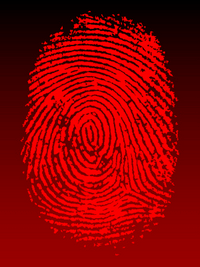Each and every individual fingerprint has its own unique characteristics that make it different from everyone else’s. In fact, fingerprints are so different that one person may be identified by his fingerprints alone. Many criminals are identified after leaving fingerprints behind at a crime scene. Forensic experts work together in order to find a positive match. Although each and every fingerprint is unique, each print has at least one specific pattern that it follows along with other characteristics. These special patterns and characteristics are used in order to pair a fingerprint with the person to whom it belongs.
Arch fingerprint patterns are found in approximately 5% of fingerprints that have been recorded. There are four different types of arches, including the plain arch, tented arch, radial arch and ulnar arch. Plain arches are defined when a single fingerprint line enters from one side of the fingerprint, creates a “wave” in the middle and then exits on the opposite side of the print. Tented arches, unlike plain arches, do not have a simple “flow.” There are up-thrusts in tented arches that are usually found in the middle of the print. Deltas, the point on a ridgeline that separates into two and is located directly at or in front of the separation line, are only found in radial arches and ulnar arches. To be considered a delta in an arch, no ridgelines may recurve and go through the core and delta point. Radial arches slant towards the thumb and have one delta. Unlar arches have a ridgeline that slants in the direction of the little finger.
Fingerprint Loop
The most common fingerprint pattern, loops are found in approximately 60 to 70% of recorded fingerprints. To be defined as a loop, the fingerprint must contain one delta and a core. In a loop, in order to be considered a delta, the ridgeline must curve back in front of the delta point. Loops are defined by one or more ridges that enter on either side of the fingerprint, curve around and touch, or intersect with the line that runs from the delta to the core. The loop then ends in the direction that it entered. Loops may also be identified by the “ridge count.” A ridge count is taken when you draw an imaginary line from the delta point to the core of the fingerprint, and then count the intersecting lines. Radial loops are less common and are usually found on the index finger. These loops slope in the direction of the thumb. Ulnar loops slope in the direction of the little finger.
Fingerprint Whorl
Whorls are more common than arches, but less common than loops. This fingerprint pattern is found in 25 to 35% of recorded fingerprints. Whorls are defined by two or more deltas. Plain whorls contain one or more ridgelines that make a complete journey, beginning and ending in the same place. Plain whorls often contain two deltas. Double loop whorls have two separate ridgeline formations that separate around the core. Two deltas are also found in double loop whorls and they also consist of ridgelines that make a complete round in the fingerprint, beginning and ending in the same spot.
Fingerprint Characteristics
Besides the three main fingerprint types, there are 8 different characteristics associated with fingerprints. These characteristics include burification, trifurication, spur or hooks, dots, ending ridges, islands, bridges and double burification. Burification is defined by a ridgeline that divides into two ridgelines. Trifurications consist of a ridgeline that divides into three. Spurs or hooks are where a line exits from a ridgeline and then terminates to create a “hook” formation. Dots are stand alone points that are roughly the same size in width as they are in height. An ending ridge is where a ridgeline ends and does not touch another line. An island is a ridgeline that stands by itself and does not touch another line. Bridges are where two parallel ridgelines are connected with a single ridgeline going across, like a bridge. Double burificiation results when a single ridgeline divides twice on one line.
Fingerprints, no matter how original, can always be described as either containing arch, loop, or whorl patterns, and having at least one of the 8 characteristics described above. Without these common characteristics, identifying a fingerprint would be incredibly difficult, if not, impossible.
Interested in doing a little detective work on people? A very handy resource for checking out people is Instant Background Check.


